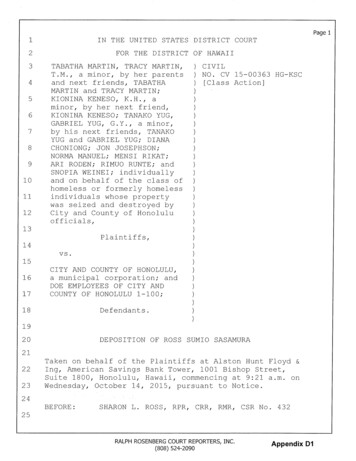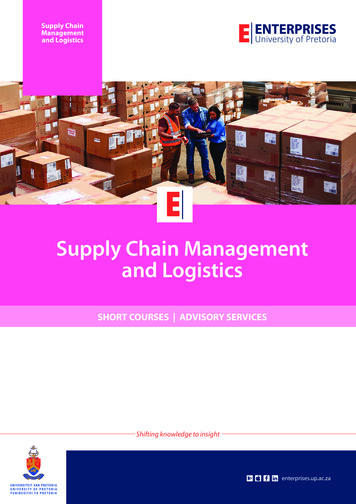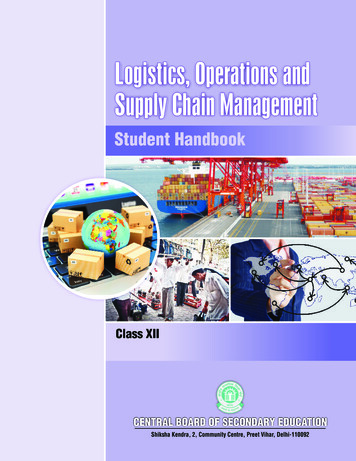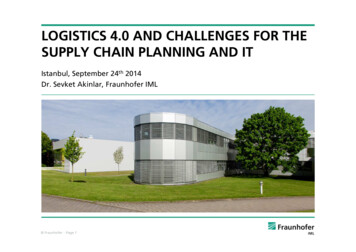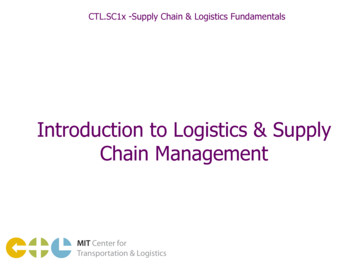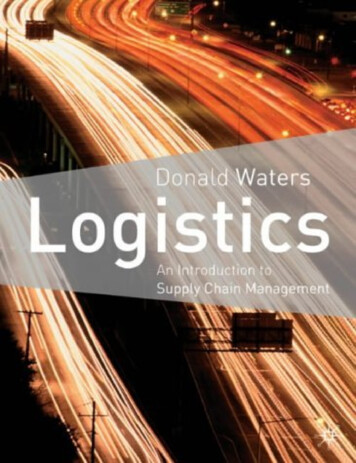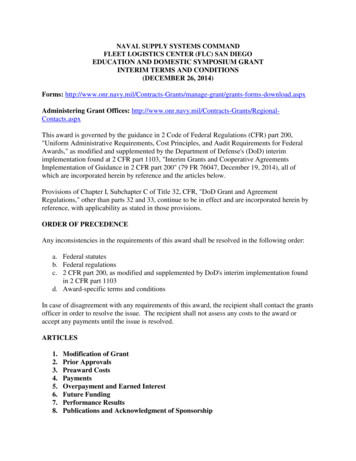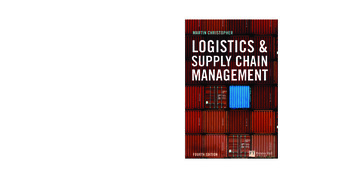
Transcription
of Marketing and Logistics at Cranfield Schoolof Mangement, a leading UK business school.He has written numerous books and articlesand is on the editorial advisory board of severalprofessional journals. Until recently he was coeditor of The International Journal of LogisticsManagement and his latest books have focusedupon relationship marketing, logistics and supplychain management.www.martin-christopher.infoIn fact, the real competition today is not between companies, but betweensupply chains. The winning approach to supply chains is an integratedperspective that takes account of networks of relationships, sustainabilityand product design, as well as the logistics of procurement, distribution,and fulfilment. Logistics & Supply Chain Management examines the tools,core processes and initiatives that ensure businesses can gain and maintaincompetitive advantage.The fourth edition has been updated and now contains four new chapters covering: MANAGING SUPPLY CHAIN RELATIONSHIPS PRODUCT DESIGN IN THE SUPPLY CHAIN MATCHING SUPPLY AND DEMAND CREATING A SUSTAINABLE SUPPLY CHAIN‘For many years now, Martin Christopher’s book has been my defaultrecommendation to anyone seeking to acquire a quick yet comprehensivegrasp of supply chain issues and management. Whether you are a recententrant to the field or a seasoned practitioner looking for inspiration, thisbook is for you!’ Bjorn Vang Jensen, Vice President, Global Logistics, Electrolux‘You must read this book for his assessment of the challenges that lieahead.’ Dr John Gattorna, supply chain ‘thought leader’ and author of DynamicSupply Chains‘A powerful book for executives and practitioners. It emphasises the“end-to-end” view of supply chains, focusing on both cost efficiency andvalue creation. The principles and concepts are illustrated with practicalexamples and applications. It is a great contribution.’ Professor Hau Lee,Stanford Graduate School of Business, USAMARTIN CHRISTOPHERLOGISTICS &SUPPLY CHAINMANAGEMENTThis updated fourth editionof the bestselling Logistics &Supply Chain Management isthe practical guide to all the keytopics in an integrated approachto supply chains, including: The link between logistics andcustomer value Logistics and the bottom line –measuring costs and performance Creating a responsive supply chain Managing the global pipeline Managing supply chain relationships Managing risk in the supply chain Matching supply and demandMARTIN CHRISTOPHERHe has held appointments as Visiting Professorat universities around the world. ProfessorChristopher is a Fellow of The CharteredInstitute of Marketing, The Chartered Instituteof Logistics and Transport and The CharteredInstitute of Purchasing & Supply. In 1987 hewas awarded the Sir Robert Lawrence medalof The Chartered Institute of Logistics andTransport for his contribution to the developmentof logistics education in Britain. In 2005 he wasawarded the Distinguished Service Award ofthe USA Council for Supply Chain ManagementProfessionals. In 2007 he was designatedas Foundation Professor by The CharteredInstitute of Purchasing & Supply. Martin has alsoworked as a consultant for major internationalcompanies in North America, Europe, the FarEast and Australasia.Effective design and management of supply chain networks can cut costsand enhance customer value. The supply chain can be a sustainable sourceof advantage in today’s turbulent global marketplace, where demand isdifficult to predict and supply chains need to be more flexible as a result.LOGISTICS & SUPPLY CHAIN MANAGEMENTMartin Christopher is Emeritus Professor Creating a sustainable supply chain Product design in the supply chainMANAGEMENTVisit our website atwww.pearson-books.comVisit our website atDesign: Dan Mogfordwww.pearson-books.comFOURTH EDITION
Logistics & SupplyChain Management
In an increasingly competitive world, we believe it's quality ofthinking that gives you the edge – an idea that opens newdoors, a technique that solves a problem, or an insight thatsimply makes sense of it all. The more you know, the smarterand faster you can go.That's why we work with the best minds in business and financeto bring cutting-edge thinking and best learning practice to aglobal market.Under a range of leading imprints, including Financial TimesPrentice Hall, we create world-class print publications andelectronic products, bringing our readers knowledge, skills andunderstanding, which can be applied whether studying or at work.To find out more about Pearson Education publications, or tell usabout the books you'd like to find, you can visit us atwww.pearsoned.co.uk
[MARTIN CHRISTOPHERLogistics & SupplyChain ManagementFourth Edition]
PEARSON EDUCATION LIMITEDEdinburgh GateHarlow CM20 2JETel: 44 (0)1279 623623Fax: 44 (0)1279 431059Website: www.pearsoned.co.ukFirst published in Great Britain in 1992Second edition 1998Third edition 2005Fourth edition 2011 Pearson Education Limited 2011The right of Martin Christopher to be identified as author of this work has been assertedby him in accordance with the Copyright, Designs and Patents Act 1988.All rights reserved. No part of this publication may be reproduced, stored in a retrievalsystem, or transmitted in any form or by any means, electronic, mechanical,photocopying, recording or otherwise, without either the prior written permission ofthe publisher or a licence permitting restricted copying in the United Kingdom issued by theCopyright Licensing Agency Ltd, Saffron House, 6–10 Kirby Street, London EC1N 8TS.This book may not be lent, resold, hired out or otherwise disposed of by way of trade in anyform of binding or cover other than that in which it is published, without the prior consentof the Publishers.All trademarks used herein are the property of their respective owners. The use of any trademark in this textdoes not vest in the author or publisher any trademark ownership rights in such trademarks, nor does theuse of such trademarks imply any affiliation with or endorsement of this book by such owners.Pearson Education is not responsible for the content of third party internet sites.ISBN: 978-0-273-73112-2British Library Cataloguing-in-Publication DataA catalogue record for this book is available from the British LibraryLibrary of Congress Cataloging-in-Publication DataChristopher, Martin.Logistics and supply chain management : creating value-adding networks / MartinChristopher. -- 4th ed.p. cm.Includes index.ISBN 978-0-273-73112-2 (pbk.)1. Business logistics--Cost effectiveness. 2. Delivery of goods--Management. I.Title.HD38.5.C46 2011658.5--dc22201003370911 10 9 8 7 6 5 4 3 2 114 13 12 11 10Typeset in Swiss Light 9.25 pt/12 pt by 30Printed and bound in Great Britain by Henry Ling Ltd, Dorchester, Dorset
About the authorMartin Christopher is Emeritus Professor of Marketing and Logistics at CranfieldSchool of Management in the United Kingdom. His work in the field of logisticsand supply chain management has gained international recognition. He has published widely and his books have been translated into many languages. MartinChristopher co-founded the International Journal of Logistics Management and wasits joint editor for 18 years. He is a regular contributor to conferences and workshops around the world.In addition to working with many companies in an advisory capacity he is also aVisiting Professor at universities in the UK, Australia, Spain and Sweden.Martin Christopher is an Emeritus Fellow of the Chartered Institute of Logisticsand Transport. He is also a Fellow of the Chartered Institute of Purchasing andSupply and a Fellow of the Chartered Institute of Marketing. He is the recipient ofthe Distinguished Service Award of the USA Council of Supply Chain ManagementProfessionals.v
ContentsAbout the author vPreface xPublisher's acknowledgements xi1Logistics, the supply chain and competitive strategy1Supply chain management is a wider concept than logistics 2Competitive advantage 4The supply chain becomes the value chain 9The mission of logistics management 11The supply chain and competitive performance 13The changing competitive environment 152Logistics and customer value27The marketing and logistics interface 28Delivering customer value 29What is customer service? 31The impact of out-of-stock 33Customer service and customer retention 34Market-driven supply chains 38Defining customer service objectives 42Setting customer service priorities 46Setting service standards 503Measuring logistics costs and performance57Logistics and the bottom line 58Logistics and shareholder value 62Logistics cost analysis 66The concept of total cost analysis 67Principles of logistics costing 70Customer profitability analysis 72Direct product profitability 78Cost drivers and activity-based costing 804Matching supply and demand83The lead-time gap 83Improving the visibility of demand 85The supply chain fulcrum 87Forecast for capacity, execute against demand 89Demand management and planning 89Collaborative planning, forecasting and replenishment 94vii
5creating the responsive supply chain99Product 'push' versus demand 'pull' 104The Japanese philosophy 109The foundations of agility 112A routemap to responsiveness 1166strategic lead-time management121Time-based competition 121Lead-time concepts 125Logistics pipeline management 1297the synchronous supply chain141The extended enterprise and the virtual supply chain 142The role of information in the virtual supply chain 144Laying the foundations for synchronisation 147'Quick response' logistics 150Production strategies for quick response 153Logistics systems dynamics 1548complexity and the supply chain159The sources of supply chain complexity 161The cost of complexity 165Product design and supply chain complexity 166Mastering complexity 1679Managing the global pipeline171The trend towards globalisation in the supply chain 173Gaining visibility in the global pipeline 178Organising for global logistics 180Thinking global, acting local 184The future of global sourcing 18510 Managing risk in the supply chain189Why are supply chains more vulnerable? 190Understanding the supply chain risk profile 193Managing supply chain risk 198Achieving supply chain resilience 20611 the era of network competition211The new organisational paradigm 212Collaboration in the supply chain 214Managing the supply chain as a network 217Seven major business transformations 218The implications for tomorrow's logistics managers 220viiicontents
Supply chain orchestration 222From 3PL to 4PL 22312 overcoming the barriers to supply chain integration227Creating the logistics vision 228The problems with conventional organisations 228Developing the logistics organisation 232Logistics as the vehicle for change 236Benchmarking 23713 creating a sustainable supply chain241The triple bottom line 241Greenhouse gases and the supply chain 243Reducing the transport-intensity of supply chains 245Peak oil 247Beyond the carbon footprint 248Reduce, reuse, recycle 250The impact of congestion 25214 the supply chain of the future257Emerging mega-trends 258Shifting centres of gravity 259The multi-channel revolution 261Seeking structural flexibility 2642020 vision 266Index 269contentsix
PrefaceWhen the first edition of this book was published in 1992, supply chain managementas an idea was still in its infancy and relatively few companies had made it a priority.The same was true for logistics management, although its precursor, distributionmanagement, was increasingly being recognised as important both in terms of costand for its potential impact on sales.In the intervening years from the first to the fourth edition, many things have happened. Firstly, there is now a much greater understanding of the role that supplychain management plays in creating competitive advantage. Whereas previouslythe focus was primarily tactical with a concern for optimising costs, now there ismuch more of a strategic focus with the emphasis on value creation and delivery.The second major change is the recognition that supply chain management is notjust an extension of logistics management, but rather that it is about managingrelationships across the complex networks that today's supply chains have become.A third significant change over that period is that the business environment hasbecome a lot more volatile and hence less predictable. This transition from a relatively stable world to one that is much more turbulent requires supply chains to becapable of changing rapidly to meet changed circumstances.These changes are reflected in the additional material included in this new edition.Thus complexity management and the challenge of making the transition from aforecast-driven to a demand-driven business model are given greater emphasis.As ever, I have been greatly influenced in my thinking by the ideas and contributions of colleagues. I have had the privilege over the years to work with manyacademics and practitioners around the world who have provided me with inspiration as well as feedback on my ideas on how modern supply chains should bedesigned and managed. Long-standing collaborators include Alan Braithwaite,Chairman of LCP Consulting, Professor John Gattorna of Macquarie University,Australia, Professor Douglas Lambert of Ohio State University, USA and ProfessorDenis Towill of Cardiff University, UK.More recently I have benefited greatly from sharing ideas with Dr Omera Khan ofManchester University, UK, Dr Matthias Holweg of Cambridge University, UK andDr Janet Godsell and Dr Uta Jüttner, both colleagues at Cranfield University. I thankthem all.Finally I want to thank Tracy Stickells who has skilfully managed the productionof the manuscript for this book – a complex logistics process in itself.MARTIN CHRISTOPHEREMERITUS PROFESSOR OF MARKETING & LOGISTICSCENTRE FOR LOGISTICS AND SUPPLY CHAIN MANAGEMENTCRANFIELD UNIVERSITY, UKx
Publisher's AcknowledgementsWe are grateful to the following for permission to reproduce copyright material:FiguresFigure 1.7 from Competitive Advantage, The Free Press (Porter, M.E. 1985), Reprintedwith the permission of The Free Press, a Division of Simon & Schuster, Inc.,from COMPETETIVE ADVANTAGE: Creating and Sustaining Superior Performanceby Michael E. Porter. Copyright 1985, 1998 by Michael E. Porter. All rightsreserved.; Figure 1.9 from Integrating the Supply Chain, International Journal ofPhysical Distribution and Materials Management, 19 (8) (Stevens, G.C. 1989),International Journal of Physical Distribution and Logistics Management by Scott,C. and Westbrook, R. Copyright 1991 by EMERALD GROUP PUBLISHING LIMITED.Reproduced with permission of EMERALD GROUP PUBLISHING LIMITED in theformat Textbook via Copyright Clearance Center. ; Figure 2.2 from 'Stock-outs causewalkouts', Harvard Business Review, May (Corsten, D. and Gruen, T. 2004); Figure3.10 from Logistics – The Battleground of the 1990s, A.T. Kearney (Hill, G.V.); Figure3.11 from Managing the Supply Chain: A Strategic Perspective, Macmillan Press(Gattorna, J.L. and Walters, D.W. 1996); Figure 6.13 from 'New strategic tools forsupply chain management', International Journal of Physical Distribution of LogisticsManagement, 21 (1) (Scott, C. and Westbrook, R. 1991), Emerald; Figure 9.3 fromSupply Chain Resilience, Report on behalf of the Department of Transport, CranfieldSchool of Management (2003)TablesTable on page 74 from 'The Customer Profit Centre', Focus, 2 (2) (Hill, G.V. andHarland, D.V. 1983), Institute of Logistics and Distribution Management; Table 10.1from Supply Chains in a Vulnerable, Volatile World, A.T. Kearney (2003)TextQuote on page 136 from The Scotsman, 14/02/2007; Extract on page 160 fromThe Times, 21/04/2010; Extract on page 186 from Disenchanted companies beginmoving production back to UK, The Times, 30/12/2009; Article on page 195 fromSupply Chains in a Vulnerable, Volatile World (A.T. Kearney 2003); Article on page 244from 12,000-mile round trip to have seafood shelled, Daily Telegraph, 16/11/2006, Telegraph Media Group Limited 2006; Extract on page 244 from MasteringCarbon Management: Balancing Trade-Offs to Optimise Supply Chain Efficiencies,IBM Global Services (Butner, K., Geuder, D. and Hittner, J. 2008), Reprint courtesyof International Business Machines Corporation, 2008 International BusinessMachines Corporation; Extract on page 252 from Supply Management, 15 February2007, www.supplymanagement.com; Extract on page 254 from 'Intelligent TransportSystems', Postnote, January, No. 322 (UK Parliamentary Office of Science andxi
Technology 2009), Crown Copyright material is reproduced with permission under theterms of the Click-Use Licence; Extract on page 260 from 'Global Trends in Energy',The McKinsey Quarterly, January 2007 (Bozon, I.J.H., Campbell, W.J. and Lindstrand,M.), Excerpt from “Global Trends in Energy”, January 2007, McKinsey Quarterly, www.mckinseyquarterly.com. Copyright (c) 2010 McKinsey & Company. All rights reserved.Reprinted by permission. ; Article on page 261 from Web-savvy housewives sabotageefforts to save Japan's economy from stagnation, The Times, 02/04/2010In some instances we have been unable to trace the owners of copyright material, andwe would appreciate any information that would enable us to do so.xiiPublisher's acknowledgements
Logistics, the supplychain and competitivestrategyMM1Supply chain management is a wider concept thanlogisticsMMCompetitive advantageMMThe supply chain becomes the value chainMMThe mission of logistics managementMMThe supply chain and competitive performanceMMThe changing competitive environmentLogistics and supply chain management are not new ideas. From the building ofthe pyramids to the relief of hunger in Africa, the principles underpinning the effective flow of materials and information to meet the requirements of customers havealtered little.Throughout the history of mankind wars have been won and lost through logisticsstrengths and capabilities – or the lack of them. It has been argued that the defeat ofthe British in the American War of Independence can largely be attributed to logisticsfailure. The British Army in America depended almost entirely upon Britain for supplies. At the height of the war there were 12,000 troops overseas and for the mostpart they had not only to be equipped, but fed from Britain. For the first six years ofthe war the administration of these vital supplies was totally inadequate, affecting thecourse of operations and the morale of the troops. An organisation capable of supplying the army was not developed until 1781 and by then it was too late.1In the Second World War logistics also played a major role. The Allied Forces’invasion of Europe was a highly skilled exercise in logistics, as was the defeatof Rommel in the desert. Rommel himself once said that ‘ before the fightingproper, the battle is won or lost by quartermasters’.1
It is only in the recent past that business organisations have come to recognisethe vital impact that logistics management can have in the achievement ofcompetitive advantage.However, whilst the Generals and Field Marshals from the earliest times haveunderstood the critical role of logistics, strangely it is only in the recent past thatbusiness organisations have come to recognise the vital impact that logistics management can have in the achievement of competitive advantage. Partly this lack ofrecognition springs from the relatively low level of understanding of the benefits ofintegrated logistics. As early as 1915, Arch Shaw pointed out that:The relations between the activities of demand creation and physical supply illustrate the existence of the two principles of interdependence and balance.Failure to co-ordinate any one of these activities with its group-fellows and alsowith those in the other group, or undue emphasis or outlay put upon any oneof these activities, is certain to upset the equilibrium of forces which meansefficient distribution. The physical distribution of the goods is a problem distinct from thecreation of demand Not a few worthy failures in distribution campaignshave been due to such a lack of co-ordination between demand creation andphysical supply Instead of being a subsequent problem, this question of supply must be metand answered before the work of distribution begins.2It is paradoxical that it has taken almost 100 years for these basic principles oflogistics management to be widely accepted.What is logistics management in the sense that it is understood today?There are many ways of defining logistics but the underlying concept might bedefined as:Logistics is the process of strategically managing the procurement, movement and storage of materials, parts and finished inventory (and the relatedinformation flows) through the organisation and its marketing channels insuch a way that current and future profitability are maximised through thecost-effective fulfilment of orders.This basic definition will be extended and developed as the book progresses, but itmakes an adequate starting point.Supply chain management is a wider conceptthan logisticsLogistics is essentially a planning orientation and framework that seeks to createa single plan for the flow of products and information through a business. Supplychain management builds upon this framework and seeks to achieve linkage andco-ordination between the processes of other entities in the pipeline, i.e. suppliers2LOGISTICS & SUPPLY CHAIN MANAGEMEN T
and customers, and the organisation itself. Thus, for example, one goal of supplychain management might be to reduce or eliminate the buffers of inventory thatexist between organisations in a chain through the sharing of information ondemand and current stock levels.It will be apparent that supply chain management involves a significant changefrom the traditional arm’s-length, even adversarial, relationships that so oftentypified buyer/supplier relationships in the past. The focus of supply chain management is on co-operation and trust and the recognition that, properly managed,the ‘whole can be greater than the sum of its parts’.The definition of supply chain management adopted in this book is:The management of upstream and downstream relationships with suppliersand customers in order to deliver superior customer value at less cost to thesupply chain as a whole.Thus the focus of supply chain management is upon the management of relationships in order to achieve a more profitable outcome for all parties in the chain. Thisbrings with it some significant challenges since there may be occasions when thenarrow self-interest of one party has to be subsumed for the benefit of the chain asa whole.Whilst the phrase ‘supply chain management’ is now widely used, it could beargued that it should really be termed ‘demand chain management’ to reflect thefact that the chain should be driven by the market, not by suppliers. Equally theword ‘chain’ should be replaced by ‘network’ since there will normally be multiplesuppliers and, indeed, suppliers to suppliers as well as multiple customers andcustomers’ customers to be included in the total system.Figure 1.1 illustrates this idea of the firm being at the centre of a network of suppliers and customers.Figure 1.1 The supply chain networkExtending this idea it has been suggested that a supply chain could more accurately be defined as:LOGISTIC S, THE SUPPLY CHAIN AND COMPETITIVE STRATEGY3
A network of connected and interdependent organisations mutually andco-operatively working together to control, manage and improve the flow ofmaterials and information from suppliers to end users.Source: J. AITkEn3Competitive advantageA central theme of this book is that effective logistics and supply chain management can provide a major source of competitive advantage – in other words aposition of enduring superiority over competitors in terms of customer preferencemay be achieved through better management of logistics and the supply chain.The foundations for success in the marketplace are numerous, but a simplemodel is based around the triangular linkage of the company, its customers and itscompetitors – the ‘Three Cs’. Figure 1.2 illustrates the three-way relationship.Figure 1.2 Competitive advantage and the ‘Three Cs’CustomersNeeds seeking benefitsat acceptable pricesValuelVaAssets andutilisationueCostdifferentialsCompanyAssets andutilisationCompetitorSource: Ohmae, k., The Mind of the Strategist, Penguin Books, 1983The source of competitive advantage is found firstly in the ability of the organisation to differentiate itself, in the eyes of the customer, from its competition, andsecondly by operating at a lower cost and hence at greater profit.Seeking a sustainable and defensible competitive advantage has become theconcern of every manager who is alert to the realities of the marketplace. It is nolonger acceptable to assume that good products will sell themselves, neither is itadvisable to imagine that success today will carry forward into tomorrow.Let us consider the bases of success in any competitive context. At its mostelemental, commercial success derives from either a cost advantage or a valueadvantage or, ideally, both. It is as simple as that – the most profitable competitorin any industry sector tends to be the lowest-cost producer or the supplier providing a product with the greatest perceived differentiated values.4LOGISTICS & SUPPLY CHAIN MANAGEMEN T
Put very simply, successful companies either have a cost advantage or theyhave a value advantage, or – even better – a combination of the two. Cost advantage gives a lower cost profile and the value advantage gives the product oroffering a differential ‘plus’ over competitive offerings.Let us briefly examine these two vectors of strategic direction.1 Cost advantageIn many industries there will typically be one competitor who will be the low-costproducer and often that competitor will have the greatest sales volume in thesector. There is substantial evidence to suggest that ‘big is beautiful’ when itcomes to cost advantage. This is partly due to economies of scale, which enablefixed costs to be spread over a greater volume, but more particularly to the impactof the ‘experience curve’.The experience curve is a phenomenon with its roots in the earlier notion ofthe ‘learning curve’. Researchers in the Second World War discovered that it waspossible to identify and predict improvements in the rate of output of workers asthey became more skilled in the processes and tasks on which they were working.Subsequent work by Boston Consulting Group, extended this concept by demonstrating that all costs, not just production costs, would decline at a given rate asvolume increased (see Figure 1.3). In fact, to be precise, the relationship that theexperience curve describes is between real unit costs and cumulative volume.Real costs per unitFigure 1.3 The experience curveCumulative volumeTraditionally it has been suggested that the main route to cost reduction wasthrough the achievement of greater sales volume and in particular by improvingmarket share. However, the blind pursuit of economies of scale through volumeincreases may not always lead to improved profitability – the reason being thatin today’s world much of the cost of a product lies outside the four walls of thebusiness in the wider supply chain. Hence it can be argued that it is increasinglythrough better logistics and supply chain management that efficiency and productivity can be achieved leading to significantly reduced unit costs. How this can beachieved will be one of the main themes of this book.LOGISTIC S, THE SUPPLY CHAIN AND COMPETITIVE STRATEGY5
Logistics and supply chain management can provide a multitude of waysto increase efficiency and productivity and hence contribute significantly toreduced unit costs.2 Value advantageIt has long been an axiom in marketing that ‘customers don’t buy products, theybuy benefits’. Put another way, the product is purchased not for itself but for thepromise of what it will ‘deliver’. These benefits may be intangible, i.e. they relatenot to specific product features but rather to such things as image or service. Inaddition, the delivered offering may be seen to outperform its rivals in some functional aspect.Unless the product or service we offer can be distinguished in some way fromits competitors there is a strong likelihood that the marketplace will view it as a‘commodity’ and so the sale will tend to go to the cheapest supplier. Hence theimportance of seeking to add additional values to our offering to mark it out fromthe competition.What are the means by which such value differentiation may be gained?Essentially the development of a strategy based upon added values will normallyrequire a more segmented approach to the market. When a company scrutinisesmarkets closely it frequently finds that there are distinct ‘value segments’. In otherwords, different groups of customers within the total market attach different importance to different benefits. The importance of such benefit segmentation lies inthe fact that often there are substantial opportunities for creating differentiatedappeals for specific segments. Take the car industry as an example. Most volumecar manufacturers such as Toyota or Ford offer a range of models positioned atdifferent price points in the market. However, it is increasingly the case that eachmodel is offered in a variety of versions. Thus at one end of the spectrum may bethe basic version with a small engine and two doors and at the other end, a fourdoor, high-performance version. In between are a whole variety of options, each ofwhich seeks to satisfy the needs of quite different ‘benefit segments’. Adding valuethrough differentiation is a powerful means of achieving a defensible advantage inthe market.Equally powerful as a means of adding value is service. Increasingly it is thecase that markets are becoming more service-sensitive
The concept of total cost analysis About the author v Preface x Publisher's acknowledgements xi 1 Logistics, the supply chain and competitive strategy 1 Supply chain management is a wider concept than logistics 2 Competitive advantage 4 The supply chain becomes the value chain 9 The mission of logistics management
